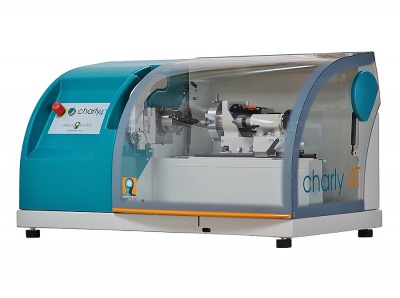CNC machine tool for turning
MÉCANUMÉRIC markets the CharlyRobot 4T, a compact industrial CNC lathe for a variety of turning operations, suitable for use in a wide range of industrial sectors and for training purposes. With this lathe, it is possible to machine parts on one or more axes with vertical or horizontal rotation.
The CharlyRobot 4T turning machine is available in two versions: standard or pro. The pro version has a chuck diameter of 125 mm, compared with 80 mm for the standard version. The spindle power is also greater, at 0.75 kW (pro) compared with 0.4 kW (standard).
The Charly4T turning machine
This machine tool is compact and takes up very little space. It is ergonomically designed to ensure a good quality of work for operators. Its design is as modern as its construction. The software supplied with the machine enables graphic and automatic programming.
Mechanical turning operations
Numerically controlled mechanical turning is a common machining operation in industry. It is used for the main turning operations such as :
- facing
- turning
- creating grooves
- reaming
- drilling
- threading,
- or following complex profiles.
These operations involve removing material from the workpiece. Only soft materials and soft metals such as brass or aluminium, for example, can be machined on our CNC lathe.
Operation and technology
The operation of a CNC turning machine is simple. A chuck holds the workpiece during the turning operation. The cutting tool is attached to the turret. The cutting tool advances towards the chuck and encounters the moving workpiece. The speed of rotation of the workpiece varies according to the type of machining required. Several types of tool can be fitted to the turret. During machining, the cutting speed is constant thanks to the continuous variation in spindle speed.
Turning operations allow material to be removed from both the outside of a part (surface) and the inside. These operations can involve all or part of the inner and/or outer surface of a part.
Numerically controlled technology provides traditional lathes with additional functionalities. These features reduce the risk of error and the production of non-compliant parts. This is because a 3D model is produced digitally before being manufactured. The digital tool also makes it possible to achieve consistent precision even when producing a small series. This increases productivity.
The operator's work is also greatly simplified. What's more, their work area is safe. Access to the machined part is only possible once the machining process is completely finished.
Advantages and applications
CNC turning machines have a very long service life. Only wearing parts (mainly cutting tools) need to be replaced to maintain machining precision and avoid damaging the part and the machine.
This low-cost technology can nevertheless be used for a wide range of operations, and is particularly well suited to training and R&D. It is also suitable for the production of small parts in the medical and pharmaceutical sectors. Wood, thermoplastics, brass and aluminium are all materials frequently machined on a CNC lathe.










